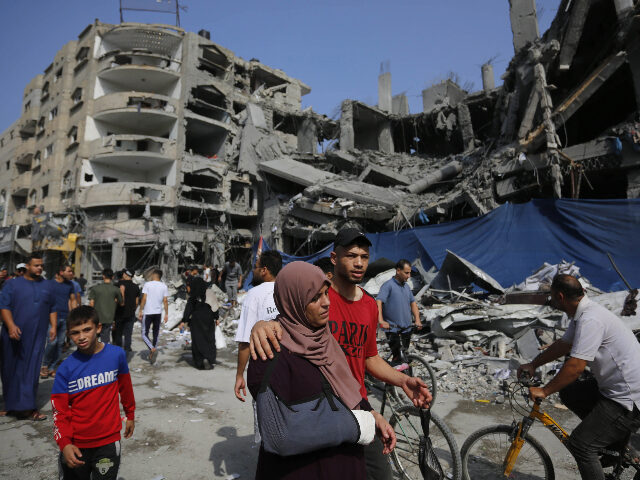W.H.O. Expresses Full Confidence in Hamas Death Tolls After Massive Revision
 Ashraf Amra/Anadolu via Getty Images
Ashraf Amra/Anadolu via Getty Images
World Health Organization (W.H.O.) spokesman Christian Lindmeier said on Tuesday that the U.N. health agency still has full confidence in the casualty figures that the Hamas-controlled Gaza Ministry of Health reported, even though the number of women and children killed in the conflict appeared to have been revised sharply downward in the latest U.N. report.
“Nothing wrong with the data. The overall data are still the same,” Lindmeier insisted. “The fact we now have 25,000 identified people is a step forward.”
“We're basically talking about 35,000 people who are dead, and, really, every life matters, doesn't it? And we know that many and many of those are women and children, and there are thousands missing under the rubble,” U.N. Human Rights Office spokeswoman Liz Throssel pitched in at the same press conference.
Lindmeier and Throssel were referring to data that the U.N. published on May 8 that appeared to show the number of women and children supposedly killed in the Gaza war had been cut in half.
Only a few days earlier, the U.N. said roughly 9,500 women and 14,500 children had been killed, but, in its May 8 report, those numbers were revised to a more precise and much lower count of 4,959 and 7,797, respectively.
When reporters questioned the new figures, a spokesman for U.N. Secretary-General Antonio Guterres blamed the “fog of war” for inaccurate early totals and said the numbers could change again under further “cross checks.”
The Israeli government said on Monday that it estimates 14,000 Hamas terrorists and 16,000 civilians have died since Hamas started the Gaza war on October 7. These figures track much better with the new U.N. figures than the doubled earlier estimates.
The U.N. changed its explanation on Monday, claiming that the estimated deaths remain the same, at about 35,000, but the lower figures published on May 8 counted only bodies that had been recovered and fully identified.
“What’s changed is the ministry of health in Gaza has updated the breakdown of fatalities, for whom full details have been documented,” spokesman Farhan Aziz Haq said.
“The United Nations teams on the ground in Gaza are unable to independently verify those figures, given the prevailing situation on the ground and the sheer volume of fatalities,” Haq added.
While the U.N., W.H.O., and various human rights agencies reaffirmed their faith in the accuracy of the Gaza health ministry’s reporting, Israeli Foreign Minister Israel Katz mocked the revised reports as “the miraculous resurrection of the dead in Gaza.”
“Anyone who relies on fake data from a terrorist organization in order to promote blood libels against Israel is antisemitic and supports terrorism,” Katz said on Monday, repeating his call for Guterres to resign.
The Times of Israel (TOI) on Monday quoted skeptical analysts who said the U.N. is reluctant to admit that many of the deaths claimed by the Gaza health minister are not even bodies that have been tabulated by ministry officials, but rather “vague figures reported by Hamas as coming from ‘reliable media sources.’”
Two researchers who examined the U.N. data, professors Lewi Stone and Gregory Rose, told TOI that the proportion of women and children in the “unregistered” deaths counted by Hamas from “reliable media sources” was vastly higher than in the hospital-registered deaths — so much higher that almost 90 percent of the extra unregistered deaths would have to be women and children to make the numbers work.
Stone and Rose dismissed that scenario as “statistically absurd.” They also noted that the information about “unregistered deaths” coming from media reports was buried much deeper in the Gaza health ministry documents than it should have been. Newer prints of this data eliminated the reference to “media reports” and claimed the unregistered deaths were people with “incomplete data,” meaning a shortage of identifying information.
Rose said:
The radical change in figures released by OCHA (the U.N. Office for the Coordination of Humanitarian Affairs) are an admission that their previously published figures were unreliable at best and manipulated false figures at most likely. The change of policy is just to save face.
When TOI relayed these concerns to OCHA, the U.N. agency repeated that it believes the total number of estimated fatalities from the conflict has not changed.
“United Nations teams in Gaza are unable to independently verify these figures, given the prevailing situation on the ground and the sheer number of fatalities,” OCHA said. “For this reason, all figures used by the U.N. clearly cite the Ministry of Health in Gaza as the source. The U.N. will verify these figures to the extent possible when conditions permit.”
Source link

